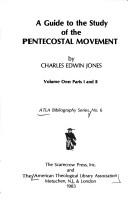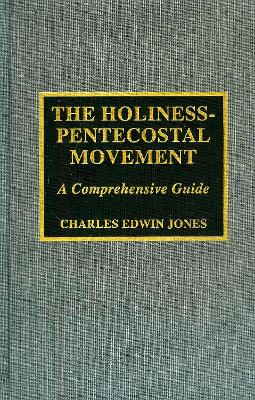ATLA Bibliography
2 primary works • 5 total works
Book 1
A comprehensive introduction to interdenominational, independent, and denominational associations, churches, schools and workers associated with the National Holiness Association, the Inter-Church Holiness Convention, the Keswick Convention, and the Holiness-Pentecostal movement, with related bibliographies including more than 5,000 items.
Book 6
This bibliographic and organizational guide to traditional Pentecostalism includes historical information on churches, associations, and evangelistic and missionary agencies, schools, and individual proponents and critics of the movement worldwide, and related bibliography. Churches and other agencies are classified by doctrinal tradition. More than 6,000 items are included.
Developing out of the (mostly Methodist) National Association for the Promotion of Holiness, the Holiness-Pentecostal Movement provided a theological consensus strong enough to unify the movement during its first decade of existence and to sweep almost the entire independent Holiness movement of the southeastern United States. Distinguished from the Holiness Movement mainly by insistence on speaking in tongues as "initial evidence" of baptism of the Holy Spirit, the teaching of the Holiness-Pentecostal Movement is foundational to a significant segment of groups descended from the Azusa Street revival, especially in Chile and South Africa. With this final volume, devoted to the Holiness-Pentecostal Movement, Charles Edwin Jones's landmark 1974 work has now been expanded into a three-part series, which breaks up his original book into 4 volumes on The Wesleyan Holiness Movement (2 Volumes), The Keswick Movement, and The Holiness-Pentecostal Movement. The series provides materials for study of doctrine, worship, institutional development, and personalities, as well as antecedent and related movements. It serves to illustrate the history both of the Holiness Movement and the rural-urban transition in which it developed. Theological reconsiderations, realignments, and changes, as well as the nearly exponential growth of the Movement since the original book's publication, make these new publications almost absolutely necessary.
Charles Edwin Jones's landmark 1974 work has now been expanded into a three-part series, which breaks up his original book into 4 volumes on The Wesleyan Holiness Movement (2 Volumes), The Keswick Movement, and The Holiness-Pentecostal Movement. This volume introduces researchers to the leaders, ideas, and institutions of the Keswick Movement, a strand of holiness teaching that was embraced by many evangelicals who came from the more Calvinistic wing of Protestantism, especially Anglicans, Baptists, Congregationalists, and Presbyterians. The Keswick Movement is the most difficult of the three main holiness traditions to delineate. Unlike the Wesleyan Holiness and Holiness Pentecostal traditions, the Keswick Movement has not gone through a definitive period of careful theological refining and institutional boundary setting. The series provides materials for study of doctrine, worship, institutional development, and personalities, as well as antecedent and related movements. It will serve to illustrate the history both of the Holiness Movement and the rural-urban transition in which it developed. Theological reconsiderations, realignments, and changes, as well as the nearly exponential growth of the Movement since the original book's publication, make these new publications almost absolutely necessary. The guides retain all of the good and strong qualities exhibited in the first edition, and have strengthened them. Students and scholars of the Holiness Movement will not want to be without this series.
The Wesleyan Holiness Movement began out of the teachings of John Wesley, who held that Christ's atonement provided sufficient grace for the believer to live in this world continually loving God and neighbor unconditionally, although the believer's expressions of that love would not be perfect. Since its founding, different movements have been spawned and have interpreted Wesley's doctrine in their own way. The two volumes presented here represent the first installation of a three-part series that greatly expands upon Charles Jones's landmark 1974 work. This work focuses on the Wesleyan Holiness Movement, while the third and fourth volumes have the Keswick Movement and the Holiness Pentecostal Movement as their focal points. This series provides materials for study of doctrine, worship, institutional development and personalities, as well as antecedent and related movements. It will serve to illustrate the history both of the Holiness Movement and the rural-urban transition in which it developed. Theological reconsiderations, realignments, and changes, as well as the nearly exponential growth of the Movement since the book's publication, make these new publications almost absolutely necessary. The guides retain all of the good and strong qualities exhibited in the first edition, and have strengthened them. Students and scholars of the Holiness Movement will not want to be without this book.




